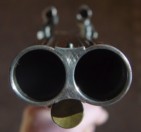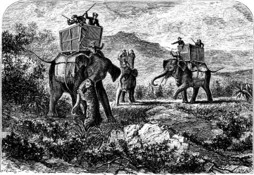The one shown here is a fine example made by Purdey in the first half of the 19th century. Like most howdah pistols, it is a large smoothbore, in this case, 0.662"(16 ga) with 7 1/2" barrels. Since they were meant for 'snatch & shoot' action, it has only a rudimentary bead front sight and no rear sight, but it is relatively light (2 pounds 6 ounces), and the balance is absolutely superb.
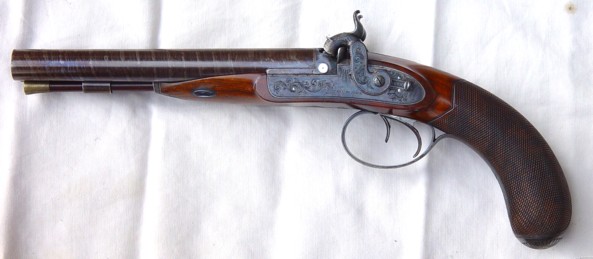

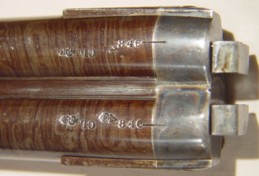 I found the pistol (in its original case) in a collection of otherwise nondescript old
guns at an auction in New England. When I saw it, I knew it 'needed' to be in my collection, and
fortunately, my wife purchased it for me as a Christmas present. As can be seen in the photograph (click on it
for a larger version), it is beautifully made, with highly polished Damascus barrels and engraved locks marked
"Purdey". On the top of the barrel is the maker's name and place of business: "J. Purdey
Prince Street Leister Square, London". The proofmarks and serial numbers (846) are on the bottom, hidden
by the stock; also present there are the initials 'CL', for Charles Lancaster, the well-regarded
barrel-maker used by Purdey, Manton and other renowned London gunsmiths. These serial numbers, according to
lists in the book
British Gunmakers by Nigel Brown, put the manufacture of this pistol in
1825.
I found the pistol (in its original case) in a collection of otherwise nondescript old
guns at an auction in New England. When I saw it, I knew it 'needed' to be in my collection, and
fortunately, my wife purchased it for me as a Christmas present. As can be seen in the photograph (click on it
for a larger version), it is beautifully made, with highly polished Damascus barrels and engraved locks marked
"Purdey". On the top of the barrel is the maker's name and place of business: "J. Purdey
Prince Street Leister Square, London". The proofmarks and serial numbers (846) are on the bottom, hidden
by the stock; also present there are the initials 'CL', for Charles Lancaster, the well-regarded
barrel-maker used by Purdey, Manton and other renowned London gunsmiths. These serial numbers, according to
lists in the book
British Gunmakers by Nigel Brown, put the manufacture of this pistol in
1825.
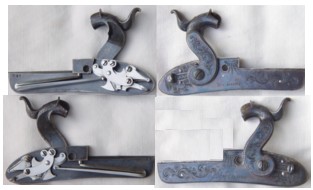 The locks have
sliding safety catches which engage the tumbler at half-cock, and the internal finish is equally as fine as
that of the outside, a mark of the best London craftsmanship. The tumblers incorporate a fly, even though the
pistol does not use set triggers.
The locks have
sliding safety catches which engage the tumbler at half-cock, and the internal finish is equally as fine as
that of the outside, a mark of the best London craftsmanship. The tumblers incorporate a fly, even though the
pistol does not use set triggers.
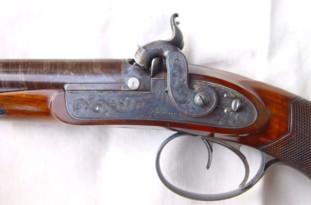 This close-up of the side shows the
platinum plugs which were used to seal the bolster after drilling out the flash channel. Note the tiny holes
in the center of the plugs, which communicate through to the flash channel. Many makers believed they relieved
some of the pressure from the exploding percussion cap and prevented the main charge from being disturbed
before it was fully ignited. These details were also the mark of a fine gun-maker of that era.
This close-up of the side shows the
platinum plugs which were used to seal the bolster after drilling out the flash channel. Note the tiny holes
in the center of the plugs, which communicate through to the flash channel. Many makers believed they relieved
some of the pressure from the exploding percussion cap and prevented the main charge from being disturbed
before it was fully ignited. These details were also the mark of a fine gun-maker of that era.
 The bottom of the pistol shows the engraving on the triggerguard, ramrod entry pipe and other
furniture.
The bottom of the pistol shows the engraving on the triggerguard, ramrod entry pipe and other
furniture.
Howdah Pistol Ballistics
The pistol was loaded with a 0.648" ball and 0.012" patch and was fired with increasing charges of FF Swiss Black Powder. The table below shows the muzzle velocity as measured over a Oehler P35 chronograph.
| Powder Charge | 30 gr | 40 gr | 50 gr | 60 gr | 70 (calc) |
| Muzzle Velocity | 523 | 678 | 719 | xx | 876 |
| Energy (fpe) | 250 | 419 | 471 | xx | 695 |
Except at the lowest charge, shooting the pistol can only be described as 'brutal' - my knuckles were bruised, and my wrists felt like they were hit with a bat. I could not get a consistent velocity reading with the chronograph at 60gr, but I had enough data to estimate the ball energy with a 70gr charge. The accuracy of the pistol was at best modest, particularly as its light weight and heavy ball made it hard to control, and the off-center kick moved the impact point a good eight inches to the side which was fired.. At an elephant-to-ground distance of about 20 feet, I could generally get a 6 inch group - not great precision, but on the other hand, a tiger is a pretty large animal - especially at close range...
